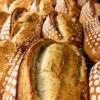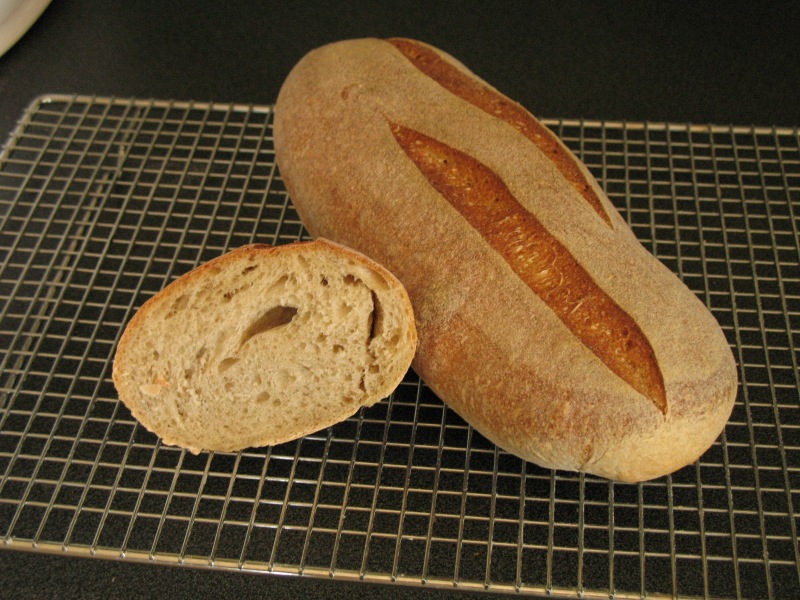
Soooooo close... I can almost taste it!
Finally, a (near) success!!
Using a couche, or more accurately a chunk of heavy cotton cut from a painter’s dropcloth (yes, new but washed) and a very generous amount of rice flour/UAP mix (50/50) rubbed into the cloth, there was NO STICKING issue whatsoever. So the loaf had no opportunity to deflate. The result is, at last, a non-flat loaf. The oven was set at 440ºF (although it should have been 475) and watched carefully through the entire baking process - I've been having Oven From Hell issues of late.
A distinct improvement from the last batch!
Things to do or improve next time:
- Slashing: Much work needed with this. Needs to be deeper and, perhaps, at more of an angle into the dough. The new cheapy dollar store knife I just got worked well though, no snagging the dough.
- Cover couched dough in plastic film to avoid top side drying more than bottom while it rises. Otherwise the two different crust textures cause busrting and (likely) hold the dough back from fluffing up as much as we want.
- Rig up better couche board.
- Less salt! Accidently added too much, though I’d taken out the excess, obviously not enough. Edible, for sure but just a touch too salty!
- Find a “softer crust” recipe; my SO still wants his bread to be more like packaged white bread: soft center with tiny holes, and a non-crusty soft crust. :shudder:
- Still need a reliable oven thermometer. I've hunted numerous kitchen sections in this town and no one's got anything better than the little coil types.
And here's the loaves:

Nice crust colour, crumb is good although it could be a little fluffier, the crust isn’t too thick n’ chewy. Overall, not bad! Minor tweaks and it should improve considerably nest time.


I don't know what formula you are using, but a suggestion for softer crumb and crust would be to use a good organic all purpose flour instead of bread flour.
As per the recipe, I used All Purpose. However, I'm in Canada and our "all purpose" and American "all purpose" are simply not the same thing.
Where typical US "all purpose", i.e. KA, has about 10% protein (a quick check of Mike Avery's flour test page shows the APs all hover in that 10% range) our Canadian "all purpose" flour, regardless of brand, is made from hard wheat and has about 13% protein, similar to US "bread flour" so we have no choice but to accept how that affects the bread making process. I will just have to find a way to compensate for our slightly higher protein levels. Can't take it out, whatever it may be.
And this higher protein content may well be part of the reason previous loaves have seemed "wetter" and more prone to spreading than rising. I dunno.
Anyone have experience with higher protein flours and can share some insights?
--------
Paul
When I was a young man, I was told about how Canadian beers are stronger than American beers. And then as I became a hobbyist brewer, I found out that American breweries measure alcohol content by volume, while Canadian brewers measure alcohol content by weight. And when you do the appropriate conversions, American and Canadian beers have about the same alcohol content. Bummer.
There's a similar gotcha in flour. American flours are standardized to 14% moisture content. Canadian flours are standardized to 12% moisture content. And this accounts for a lot of the difference in the protein content of the flour.
When I lived in the mountains, I used 14% protein flours on a regular basis. It helped overcome issues from the altitude.
Now I am using Harvest King at about 12% and different all-purpose flours around 10% The softer flours are yielding doughs that are softer and stickier, and which take longer to fully develop.
In the bakery, we needed some all-purpose flour, so we'd mix the high gluten stuff with cake flour. Worked very nicely.
Hope some of the rambling helps,
Mike
So what I should get out of that is, basically, the differences are slight enough inactuallity to not be worth considering? if Canadian flour was measued at 14% moisture or US was measured at 12, their relative protein amounts would be pretty much identical?
Now let's, for the sake of discussion, say that a recipe called for (US) AP flour at 10% but you used (US) bread flour at 13%, what changes would the increased protein do to the bread then? Would it be very perceptible? Would the bread flour dough be stickier, less or more likely to flatten or be stiff than the expected AP dough?
--------
Paul
You seem to be making baguette scoring, no need for that here, as you can see, you can do one vertical slash through the entire loaf, or two at angle, but inclined, not vertical. For softer crust remove water pan the moment you see the loaf developing color.
To be honest, I don't in the least have a grasp of the logic behind slashing other than it helps to keep the crust from bursting indiscriminately as it expands. I presume there's actual method to it and reasons for this over that type of cut but I'm completely unfamiliar with that side of things and haven't run into an instructional section on the Art of Slashing anywhere yet. If someone knows of something, please share the link!! My loaves , and probably many others', will be grateful.
As to the pattern on there now, I'm simply following the instructions and visuals.
Ooo! Thanks for the steam tip, that will be appreciated, though not particularly by me as I like crunchy crusts. But hey, I have to please other people too. Even if it's to try and gently divert them away from their misguided preference of white sliced bread.
--------
Paul
Rainbowz.
You wrote: "I don't in the least have a grasp of the logic behind slashing other than it helps to keep the crust from bursting indiscriminately as it expands."
As you said, in addition to allowing the loaf to expand "without bursting indiscriminatly", if the scoring is done at an angle about 1/2 inch deep it will (or should) produce "ears", which causes the crust to curl a bit on one side during the baking process, forming ears (or lips) on angled side of the score/slash, mostly for aesthetics.
I don't know why you would want to remove a hot steam pan from a hot oven. I never have done that and have never had a problem. The steam, if you have used the proper amount of water (1 cup give or take) should be pretty much evaporated after the first 10-15 minutes of baking with only residual steam left in the oven. The purpose of the steam, as I understand the process, is to keep the skin of the loaf moist and piable during the period of ovenspring and, along with the scoring, allows for full expansion of the loaf---these two techniques (scoring and steam) help the loaf's rise in the oven without being inhibited by a dry, tough skin/crust. In short they both work to relieve the loaf's interior pressure during ovenspring.
Howard - St. Augustine, FL
Hi Paul.
First of all great job on the bread, I think it looks excellent. A few notes on your questions. A higher protein flour will have minimal effect on the stickiness of your dough. However, it will be less likely to spread and flatten. The reason is that higher protein flour will form more gluten and the more gluten there is in the dough the tighter and higher the loaf will be. I understand that most European bread bakers dream of having access to our North American flour, Canadian and American. So we are quite blessed in that regard.
To produce bread with softer crust for your SO, you can try the following two tricks. First bake your bread in an enclosed or covered vessel the entire time that it is in the oven. If that produces a crust that is still too thick. Reduce the temperature of the oven, and of course increase the overall baking time accordingly. If this proves too much work or an impossibility, there is always a plastic bag. :)
Rudy
I've had good luck simply brushing the hot-from-the-oven loafs with butter. Use a natural bristle brush (i actually have an unused paint brush) and run it down the length of a stick of butter, then brush on. As you brush, the bristles will get hot and start to melt your butter stick when you go back for a butter refill - I keep one wrapped up in the door of the fridge - dedicated to bread brushing. No need to clean off the crumbs then, either.